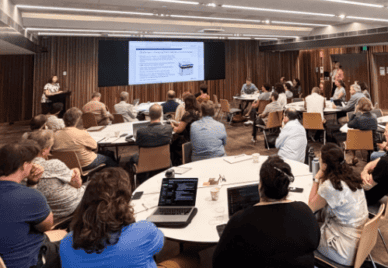
Workshop Addresses Wildlife Camera Trap, Ecoacoustic and Drone Data Challenges
Exploreabout Workshop Addresses Wildlife Camera Trap, Ecoacoustic and Drone Data Challenges
Australian researchers from the 5 spheres of Earth science – the geosphere, cryosphere, hydrosphere, biosphere and atmosphere – met in Canberra in September for the Integrated Earth 2023 conference to discuss their overlapping research topics, methods, and computing and data needs, and to map future directions.
The Earth’s oceans, ice, life forms, minerals and air are irrevocably intertwined. The scientific domains to understand these systems must, by necessity, be similarly interconnected. An example is climate simulations, which incorporate the complex processes taking place far above and deep below the surface of the Earth.
Hamish Holewa, Director, Planet Research Data Commons, ARDC and a member of the conference organising committee said, “The goals of the Integrated Earth conference align with the ARDC-led Planet Research Data Commons (Planet RDC), the national-scale data infrastructure for earth and environmental research and decision making.”
The conference highlighted the need for research communities and data infrastructures to come together to address modern cross domain societal challenges. One of the clear needs was to define a common language to enable data integration.
“Partnering across academia, research facilities including NCRIS facilities, government and industry, the Planet RDC is tackling 4 data challenges, which were identified through comprehensive consultations with the research community. By addressing these data challenges, we aim to enhance the translation of data into knowledge, which will help Australia understand and manage the environment more effectively,” said Mr Holewa.
“The initiatives we are implementing will provide us with a deeper understanding of the cumulative impacts of multiple pressures on the environment. Furthermore, they will help Australia in managing critical mineral exploration and transitioning to renewable energy more efficiently.”
The 4 data challenge areas will be integrated through broad use cases for the data infrastructure needs of government, research and industry in selected regions of national priority.
The ARDC is currently establishing partnerships to develop projects with 2 data challenges:
And is leading consultations to develop projects around the further 2 data challenges:
Keynote speaker, Dr Dalia Kirschbaum from NASA, presented about the United States’ wealth of data collection and collaborative science agencies all contributing to ambitious simulations of extreme weather and Earth systems.
Jim Walker from the University of Queensland added an Indigenous perspective to inform and support integrated earth science.
The first day featured presentations and moderated discussions about each sphere in turn with discipline leaders setting the tone, followed by ECRs discussing upcoming priorities, and a panel of experts available to answer questions from attendees in the audience.
Attendees noted the apparent overlap in themes across the spheres, that all disciplines are facing similar challenges around data volumes and data sharing, and many see the potential to come from more collaboration with Earth scientists across disciplines.
The second day focused on more extensive, cross-disciplinary discussions about their data needs and science ambitions.
The two keynote speakers for day 2 outlined the critical importance of thinking broadly about the kinds of data we value and the ways we decide to use them.
Keynote speaker, Dr Simon Hodson from CODATA (Committee on Data of the International Science Council) was sponsored by the ARDC to speak at the conference, and at the Academy of Science the next day for the Data for the People: Government Meets Research.
In his talk, he shared an ambitious vision for international data integration across the sciences, with significant efforts underway for data standardisation, sharing and collaboration.
Dr Cassandra Price from CSIRO then took attendees through Indigenous data sovereignty as a way to integrate and protect Indigenous knowledges and science.
Attendees discussed the opportunities and priorities for increased scientific collaboration across the spheres. Key outcomes from these discussions included calls for ambitious, big-vision projects to catalyse innovation across the spheres and demonstrate impact to government, and the need for further deep scientific discussions about the practicalities of improved data and science sharing.
The organising committee for Integrated Earth will develop a discussion paper to formalise the conference outcomes and provide advice to guide the next steps of integrating Australian earth science.
The Integrated Earth 2023 conference was supported by the Australian Academy of Science as an Elizabeth and Frederick White Conference and organised by AuScope, TERN, NCI, ACCESS-NRI, ARDC and IMOS, a partnership of national research infrastructure organisations funded by the Australian Government’s National Collaborative Research Infrastructure Strategy (NCRIS) to support national digital research infrastructure for Australian researchers.
View all the conference videos.
This article is based on an original article written by Adam Huttner-Coros for NCI.